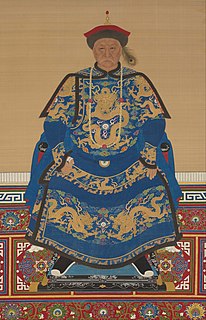| |||||
| Decades: | |||||
|---|---|---|---|---|---|
| See also: | Other events of 1667 History of China • Timeline • Years | ||||
Events from the year 1667 in China .
| |||||
| Decades: | |||||
|---|---|---|---|---|---|
| See also: | Other events of 1667 History of China • Timeline • Years | ||||
Events from the year 1667 in China .

Oboi was a prominent Manchu military commander and courtier who served in various military and administrative posts under three successive emperors of the early Qing dynasty. Born to the Guwalgiya clan, Oboi was one of four regents nominated by the Shunzhi Emperor to oversee the government during the minority of the Kangxi Emperor. Oboi reversed the benevolent policies of the Shunzhi Emperor, and vigorously pushed for clear reassertion of Manchu power over the Han Chinese. Eventually deposed and imprisoned by the new emperor for having amassed too much power, he was posthumously rehabilitated.
Hešeri, is a clan of Manchu nobility with Jianzhou Jurchens roots, originally hailing from the area which is now the modern Chinese provinces of Jilin and Liaoning. It was once one of the most important and powerful noble families in the early Qing dynasty in China, second only to the royal House of Aisin Gioro, to whom they were closely related by marriage. The power of the family reached its zenith in the period of Duke Hešeri Sonin and his third son Lord Hešeri Songgotu. Although its influence declined following Songgotu's death, clan Hešeri continued to be the hereditary nobility and play a role in Chinese politics until the demise of the Qing dynasty in early 1912.
Soni (1601–1667), also known as Sonin, and rarely Sony, was a Manchu noble of the Hešeri clan who served as one of the Four Regents of the Kangxi Emperor during the Qing dynasty (1644–1912). His clan belonged to the Plain Yellow Banner.
Suksaha was a Manchu official of the early Qing dynasty from the Nara clan. A military officer who participated in the Manchu conquest of China, Suksaha became one of the Four Regents during the early reign of the Kangxi Emperor in the Qing dynasty (1644–1912). He eventually fell out with another regent, Oboi, and was sentenced to death.
Ebilun was a Manchu noble and warrior of the Niohuru clan, most famous for being one of the Four Regents assisting the young Kangxi Emperor from 1661 to 1667, during the early Qing dynasty (1644–1912). A largely passive figure during the regency, Ebilun was disgraced following the ouster of the far more powerful regent Oboi and considered a political supporter of the latter. He was stripped of his positions by the emperor but later regained his noble rank. Many of his descendants became influential figures in the Qing imperial government.
The Four Regents of the Kangxi Emperor were nominated by the Shunzhi Emperor to oversee the government of the Qing dynasty during the early reign of the Kangxi Emperor before he came of age. The four were Sonin, Ebilun, Suksaha, and Oboi.

Puti Temple or Bodhi Temple is a Buddhist temple located in Mangshi of Dehong Dai and Jingpo Autonomous Prefecture, Yunnan, China. In Dai language, the temple is called Zangxiang, meaning Temple of Precious Stone. Covering an area of 3,125-square-metre (0.772-acre), the temple was established in 1667. Because of war and natural disasters, the temple has been rebuilt numerous times in the past 300 years.
Ganlu Temple is a Buddhist temple located on Mount Jiuhua, in Qingyang County, Anhui, China.
Events from the year 1662 in China.
Events from the year 1661 in the Qing dynasty.
Events from the year 1663 in China. Also known as 壬寅 4359 or 4299 to 卯年 4360 or 4300 in the Earthly Branches calendar.
Events from the year 1664 in China. Also known as 癸卯年 4360 or 4300 to 甲辰年 4361 or 4301.
Events from the year 1665 in China.
Events from the year 1666 in China.
Events from the year 1668 in China.
Events from the year 1669 in China.
Events from the year 1670 in China.
Events from the year 1672 in China.
Events from the year 1682 in China.
Events from the year 1686 in China.
Traveling notes of Dehong Dai and Jingpo Autonomous Prefecture, Yunnan